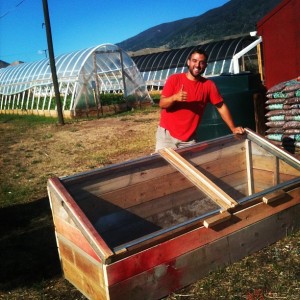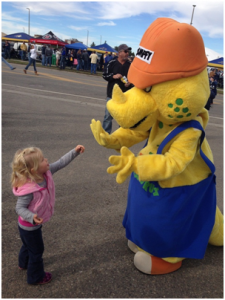Read about Roxanne’s experience educating elementary school students about energy:
I’ve never had to teach kids before, and I never thought I would ever have to, until a few weeks ago, when I did. The venue was a summer camp, hidden in the cornfields of rural Pennsylvania, an open rolling field where elementary-aged children were frolicking and gamboling around in the summer sunshine when we drove into the gravel parking area. We arrived in exaggerated workout gear (knee-high gym socks, sweatbands, jerseys) in order to fully play the part of coaches teaching kids how to become super energy-efficient champions. We had everything scripted out; it was beautiful, it was perfect, but when we got up there we realized that these kids probably weren’t going to fall for it, and so we just talked conversationally to them about saving energy around the home instead. We would ask them questions like, “Do you know what energy is? How do you use energy around the house? What are some ways you can use less energy around the house?” Then, we handed out Starburst candies for correct answers. Simple enough.

We learned a few things about teaching elementary-aged children that day. First of all, there is a huge difference between 2nd and 4th-graders, even if they look relatively similar to me from my towering height of 5’5”. Older elementary students are already too cool for these staged presentations, while the younger ones are still ready to tell you everything they know about saving energy, even if-oh what was the question? Yes, the younger ones couldn’t always remember what the question was, but they would volunteer to answer it regardless. Such reckless enthusiasm. It was quite a challenge to keep everyone’s attention on the wonders of saving energy, but we did our best. We also discovered that if you leave a bag of Starbursts on the ground while talking to elementary-aged children, some the candies may mysteriously disappear.
We ended our presentation with some games where we divided the children up into groups and had them come up with some sort of chant or skit to illustrate an energy-saving action. For instance, one of the groups’ actions was “Taking shorter showers to cut back on hot water,” so they all chanted “Take a short shower! Take a short shower” while mimicking scrubbing clean in the shower. Everyone participated, there was embarrassed laughter all around, and at the end they dispersed like firecrackers to resume racing around the field, releasing all the pent-up energy that had built up while we had tried to teach them (ironically?) about energy conservation. It’s hard to say how much of what we taught actually stuck, but the experience taught us a lot about the value of flexibility, patience, and variety when trying to teach children in a way that is fun and exciting. It was also a good starting point for hopefully more fun energy-themed programs to come. Future elementary-aged children, prepare to be energy-educated.
 Roxanne Li graduated from Cornell University in May 2012 with a B.S. in Environmental Engineering and a minor in Sustainable Energy Systems. She then went on to complete a six month internship with an environmental consulting company in Johannesburg, South Africa. Roxanne will be working on the Weatherization Innovation Pilot Project at the Commission of Economic Opportunity (CEO) in Wilkes-Barre, PA. She will provide energy education for low-income households and develop strategies to overcome barriers related to behavior changes that could reduce residential energy consumption.
Roxanne Li graduated from Cornell University in May 2012 with a B.S. in Environmental Engineering and a minor in Sustainable Energy Systems. She then went on to complete a six month internship with an environmental consulting company in Johannesburg, South Africa. Roxanne will be working on the Weatherization Innovation Pilot Project at the Commission of Economic Opportunity (CEO) in Wilkes-Barre, PA. She will provide energy education for low-income households and develop strategies to overcome barriers related to behavior changes that could reduce residential energy consumption.







